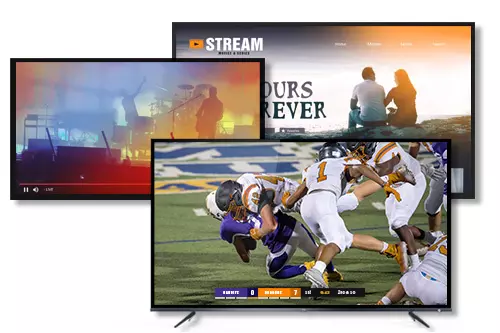Better, Stronger, FASTer: What FAST Means for the Future of TV

In an entertainment world where consumers are overwhelmed with choice and subscription fatigue, imagine a solution where you didn’t have to worry about finding the perfect thing to watch on a platform you hopefully already pay for. Instead, you can choose between a far fewer number of channels that play thematically related titles linearly. That’s how FAST streaming works.
Wait. That’s just how cable works, isn’t it? The very thing we started to move away from when the streaming giants like Netflix and Hulu started gaining popularity, resulting in millions of households “cord-cutting”? You’re right that they sound remarkably similar, but FAST TV is not a step backwards — it will play a significant role in the future of OTT and television. Let’s dive into what FAST streaming is, what makes it unique, and what it means for producers, advertisers, and consumers.
Table of Contents
What Is FAST Streaming?
Coined by Over the Top author and TVREV co-founder Alan Wolk, FAST stands for Free Ad-Supported Television. Instead of paying a subscription fee like you do with SVOD (Subscription Video on Demand) to watch ad-free series and movies, you can watch content for free with a few advertisements peppered in here and there.
This also sounds similar to AVOD (Advertising-based Video on Demand), doesn’t it? AVOD usually refers to advertising-based plans on streaming platforms (such as Hulu’s) that allow users to view VOD titles for free or a discounted monthly price in exchange for watching ads. FAST, however, is more like old school broadcast and cable because it’s linear: meaning instead of choosing a title to stream on demand whenever you wish, you watch what is currently live or tune it at a specific time.
Still confused about the difference? FAST platforms work like cable and broadcast, but the technology behind them is still streaming. That is, you can watch FAST programs on any device, including mobile, instead of forcing you to rely on satellites and set-top boxes. Advertisements can also be targeted and personalized to specific viewers rather than requiring channels to insert individual ads to everyone.
What Are FAST Platforms?
FAST platforms are service providers that offer a variety of ad-supported streaming channels. They are “platforms” the way Netflix, Hulu, and Disney+ are, though they operate differently. Some of the most popular FAST platforms include:
- Tubi
- The Roku Channel
- Pluto TV
- Peacock
- Vudu
- Plex
- FAST TV Network
And more.

What Are FAST Channels?
FAST channels work like the linear cable and satellite channels you grew up with. There’s a guide that tells you what is playing in real time and a selection of channels to choose from. Variety reports that there are over 1,400 FAST channels across 22 major service providers, providing viewers with no shortage of content to watch.
The Difference Between FAST vs. AVOD, SVOD, and OTT
Let’s clarify something really quick: FAST is a kind of OTT content model. OTT (Over-the-Top) refers to the way content is distributed, namely, online instead of through cable, broadcast, or satellite. Both FAST channels and VOD platforms like the famous streaming giants fall under the OTT umbrella.
The differences between FAST vs. AVOD and SVOD, though, are a bit more nuanced. To elaborate on the points mentioned above, you can think of it this way:
FAST streaming: Free Ad-Supported Television is the streaming version of cable TV’s original delivery format. Content titles are not on-demand; instead, different channels run pre-scheduled programs that require viewers to tune in during real time. However, unlike cable, broadcast, and satellite TV, FAST’s streaming workflow allows viewers to access content on any Internet-connected device. FAST platforms are free (or discounted) for users because they make their revenue through third-party advertisers. Essentially, viewers pay with their time and toleration of ads instead of money.
AVOD: Advertising-based Video on Demand is also (usually) free because revenue comes from inserted ads instead of subscription fees. Whereas FAST is linear, AVOD is on demand, meaning viewers can choose whatever titles are available whenever, wherever they have Internet access. Many streaming services like Netflix and Hulu offer ad-supported plans in an effort to provide a cheaper alternative for consumers.
SVOD: Subscription Video on Demand entails paying a monthly subscription fee for access to all of a platform’s content at your whims. These include the streaming platforms you’ve come to know and love (and perhaps feel a little exhausted by). The monthly price saves you the time and energy involved sitting through ads, which is what made them appealing to begin with.

FAST Streaming TV Trends
FAST streaming has grown exponentially in recent years. According to BroadcastPro, FAST experienced a 99% rise in channels in 2021, and total FAST viewership grew by 103% the same year (with a 134% growth in ad impressions, too). A study from Fact vs. Fiction also discovered that at the end of 2022, over half of consumers in the U.S. (55%) noted they use at least one FAST service such as Roku, Tubi, or Pluto TV.
Financially, FAST TV is in a good place. Though many platforms are actively searching for content to fill programming schedules, the usership is there: the U.S. free ad-supported television market is expected to reach 216 million MAUs this year, growing from $2.1 billion in 2021 to $4.1 billion.
With thousands of channels out there, FAST has nearly as much content as any of its SVOD counterparts, though not every platform has the budget for original programming. Even without such content, there are limitless re-runs of fiction and reality shows alike to choose from. However, sports is interestingly lagging behind the rise of FAST TV. It’s still an integral part, of course — plenty of channels are dedicated to sports including MMA fights and outdoor adventures — but major leagues like the NFL and NHL don’t have FAST channels yet. ESPN has also stubbornly refused to make the move likely due to fear of losing paid subscribers despite the opportunities ad-supported streaming presents.
What Draws Viewers to FAST Streaming?
While it may seem surprising that a TV format remarkably similar to cable would be this successful after all the buzz about cord-cutting when streaming platforms started taking over, it actually makes sense. SVOD isn’t going anywhere because people love being able to choose their favorite TV shows and movies whenever, wherever, and without interruptions, but subscription fatigue is hitting consumers hard. Viewers started cord-cutting because they were spending an average of $2,609 per year on cable (not to mention the cost of the boxes themselves). Netflix was a good solution, but when you also need Hulu, Disney+, Paramount+, HBO Max, STARZ, and Apple TV+ on top of it to watch what you want, the price still racks up.
The saturation of streaming services has come back to bite what was once an innovative idea, so consumers are turning to platforms that are genuinely free. While ad-free content is appreciated, consumers are proving that they don’t really mind ads that much if it saves them as much money as it does. Plus, hour-long paid TV programs usually entailed a 30% ad load — meaning around 18 minutes of ads per hour — but FAST TV shows include eight to 14 minutes of advertisements per hour instead.
FAST also offers something viewers never stopped wanting: “lean-back” viewing. Jokes circulate the internet about how long it takes couples to agree on a series or movie before bedtime approaches and it’s too late to start one. Streaming platforms present customers with an overwhelming number of choices: FAST’s linear nature, however, allows people to say, “Let’s just see what’s on,” and narrows the number of options (which is especially convenient for those who don’t care what they watch and merely want background noise while they do other tasks).
Something consumers love about FAST streaming are single-show channels. Some platforms have entire channels dedicated to series like CSI, Baywatch, Fear Factor, and more. These shows have enough episodes and fan loyalty to create an endless linear stream of content, day and night, that enables viewers to choose their favorite shows without having to pick which specific episode to watch. It’s effortless.
What Draws Advertisers to FAST Channels?
Consumers have a lot to benefit from FAST, but if the ad load is lower per hour, then what draws advertisers? Targeting. FAST platforms leverage dynamic ad insertion. Unlike cable and satellite TV where everyone tuning into a channel sees the same commercials, FAST streamers see ads based on their preferences and viewership behaviors. This kind of targeting means advertisers experience better performance and higher costs per mile.
The technology behind free ad-supported TV is evolving, too. Who knows? Maybe one day ads will even have QR codes or clickable links that can take mobile viewers directly to product pages in ways TVs never could.

The Top FAST Streaming Platforms
If there are 22 major FAST TV providers, who are they, exactly? How do they compare? Let’s take a look at some of the most popular:
Pluto TV
Pluto TV is Paramount’s answer to the rise of FAST streaming. With 72 million active monthly users (MAUs) in the third quarter of 2022 and over 250 channels, Pluto TV has solidified itself as one of the most prominent FAST TV players in the game. Though you’re unlikely to find many newly produced episodes of anything, Pluto TV does offer VOD as well.
Roku
Roku also ended 2022 with over 70 million MAUs. Yes, Roku is the name of the device itself, but it also boasts the Roku Channel, a rapidly growing FAST platform with a variety of licensed (and even some original) content. Combined with its wide range of content offerings and how easy it is to access for existing customers without turning to another platform, Roku has become, interestingly, the fifth most popular streaming service behind platforms like Netflix, Hulu, and Disney+.
Peacock
Comcast/NBCUniversal’s venture into FAST streaming includes Peacock, which offers an assortment of free movies, TV series, and hits from familiar channels like Bravo — and, of course, NBC. Peacock had 30 million active monthly users in October 2022 (though this number doesn’t reflect precisely how many were using the free ad-supported streaming tier). We’ll see how many MAUs remain when Comcast ends free Peacock access for Xfinity customers in June 2023, but for now, it’s still a good place for many viewers to watch classic shows and movies.
Xumo
From news and weather to movies and channels dedicated to Black stories and creators, Xumo boasts an assortment of compelling content and 40 million monthly active users. Comcast also owns Xumo.
Tubi
Fox’s FAST streaming platform, Tubi, reported over 51 million users in 2021 and 3.6 billion hours of content streamed. Tubi is growing fast, partly thanks to the power of Fox’s other properties it’s possible to stream, original shows, and Tubi Español.
Amazon Freevee
Amazon hasn’t released MAU numbers for its FAST TV platform, Amazon Freevee (formerly IMDb TV), but it has announced that it has 120 million users across all of its ad-supported OTT offerings (including live sports and Twitch). Amazon plans to produce a number of original programs in hopes of attracting even more viewers.
FAST Streaming: A Look Forward
So, what does FAST mean for the future of TV? It’s growing rapidly, and as industry becomes increasingly saturated with SVOD options and the economy tightens, consumers looking to save money on entertainment will keep turning to less expensive options. Sure, ads aren’t their favorite, but they’re tolerable if they make watching series, movies, sports, reality shows, and news free. A strong streaming strategy takes advantage of industry innovations to balance your bottom line with customer needs.




